|
|
|
 |
|
"OH HOW LONELY SITS THE
CITY THAT ONCE WAS FULL OF PEOPLE!
HOW LIKE A WIDOW SHE HAS BECOME, SHE THAT WAS GREAT
AMONG THE NATIONS! SHE THAT WAS A PRINCESS AMONG
THE PROVINCES HAS BECOME A VASSAL"
LAMENTATIONS 1
|
|
|
 |
|
 |
| |
In
mid-summer, on the ninth day of Av according
to the Jewish calendar, Jerusalem goes into
mourning. It’s a day of fasting in
memory of the destruction of the First
Temple and the Second. All Jerusalem’s
trendy pubs, coffee houses and cinemas close
down at dusk as people flock to the Western
Wall to chant Jeremiah’s lamentations
throughout the night.
That next evening after the fast, we members
of the Ramat Rahel archeological excavation
team gathered to inaugurate our final week
of the 2008 season. Oded Lipschits,
director of the excavation, shared his
identification with the residents of this
ancient biblical site who would have
witnessed the fire and smoke of the burning
sanctuary and holy city, just four miles to
the north. |
| |
|
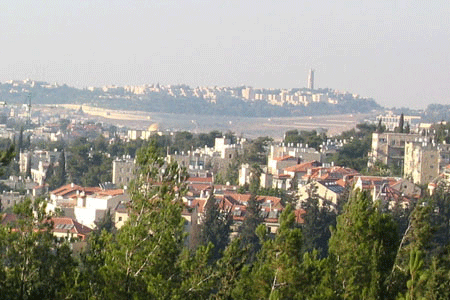 |
|
Photo:
Gila Yudkin |
|
View of Jerusalem from Tel
Ramat Rahel |
|
Note the Dome of the Rock
in the middle, a bit to the left |
|
|
This
season’s million-shekel question was, were
the residents of the Iron Age (biblical
period) citadel we have been uncovering at
Ramat Rahel, friend or foe? Were they
the “good guys,” i.e. administrators
representing the Judean king of Jerusalem?
And thus the more than a dozen stamp
impressions found in the 2,700-year-old
debris this season would have come from
storage jars collected as taxes for the
Judean monarch.
Or were the administrators actually
Babylonian in ethnicity and loyalty, i.e.
the “bad guys”? The Babylonians from
today’s southern Iraq would have replaced
the Assyrians who had originally built the
citadel as a forward position to spy over
the capital of their vassal state of Judah. |
| |
|
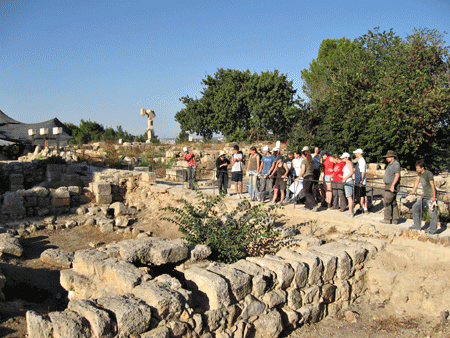 |
|
Photo:
Gila Yudkin |
|
Ramat Rahel team members
studying the Iron Age citadel |
| |
We know from
a 6-sided cuneiform prism found in Nineveh,
in northern Iraq, that the Assyrian emperor
Sennacherib boasted that he captured 46
Judean cities and numerous small towns,
along with 200,150 Judean POWs, but
“Hezekiah the Judahite king I shut up in a
cage like a bird.”
Hezekiah’s capital city did not fall to the
Assyrians due to his diligence: he built an
outer defensive wall (2 Chronicles 32:5); he
diverted the Gihon Spring water over to the
western side of his city (2 Chronicles
32:30) and he mobilized Isaiah to intercede
with the Almighty on behalf of the Judeans
(2 Kings 19:20).
Ramat Rahel whose biblical name we don’t yet
know could have been included in the small
towns captured and looted by Sennacherib.
A problem with this theory though, is that
we have found no layers of ash, signifying
destruction and conquest, either by the
Assyrians or the Babylonians. Could it
be that they just walked in? It’s a
riddle to put on hold. |
| |
| So then,
what were the finds of the Iron Age, which
starts at Ramat Rahel at the end of the
eighth century BC, in the days of Isaiah?
Most importantly, we found some 15
l’melech (meaning belonging to the king)
stamp impressions on broken jar handles.
The jars would have held agricultural
produce collected as a form of taxes to the
governor or king. |
| |
|
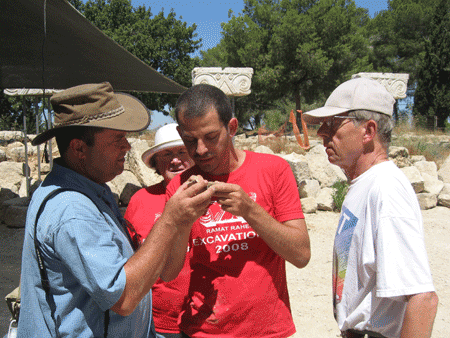 |
|
Photo:
Gila Yudkin |
|
Deciphering a stamp
impression; Dr. Oded Lipschits is on
left |
| |
|
In one locus, Iron Age pottery filled more
than thirty buckets, with lots of typical
burnished plates where the potter would have
taken a shell or stone to draw concentric
lines while the clay was still spinning on
the wheel. Other prominent finds
included pieces of a fertility figurine and
a rider on horse, similar to those found in
the City of David from the same period. |
| |
|
 |
|
Photo:
Courtesy of Oded Lipschits |
|
Grad student Luke
pick-axing in the locus with the most Iron
Age pottery |
| |
| |
|
The dig was intense and
exciting. At 5.30 each morning, as the sun
rose over the six areas of excavation,
pickaxes, hoes, shovels, buckets, brushes,
hand axes, trowels, and sifters were
wheel-barrowed out to each area. A western
breeze from the Refaim Valley and black
netting nicknamed “Joshua tents” (remember
it was Joshua who commanded the sun to stand
still: Joshua 10:12) kept us diggers cool
till late morning. Of course in August it’s
all relative! |
|
|
|
 |
|
Photo:
Courtesy of Oded Lipschits |
|
Johannes and Phil hauling
out "the collapse" from area D1 |
|
|
| We haven’t
yet solved the mystery of whether the
inhabitants of ancient Ramat Rahel were
friend or foe, but stay tuned. One
thing is sure – this season’s finds at Ramat
Rahel will provoke a vigorous discussion
among biblical scholars. There will be
another season next summer. It may be
then that we make that astounding discovery
which will enter into all subsequent history
books. |
| |
|
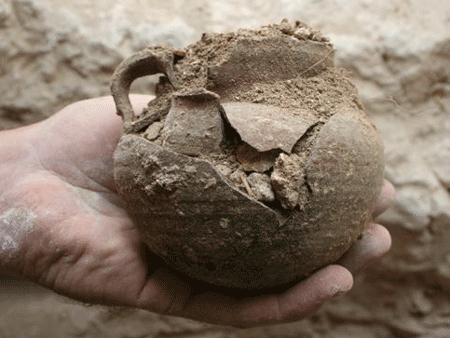 |
|
Photo:
Courtesy of Oded Lipschits |
|
Second Temple period
silver shekels were found in this jar |
| |
| In the
meantime during the coming year, scholars
and grad-students will be analyzing the
just-discovered walls, ceramic vessels,
stamp impressions, hole-mouthed jars and
other Iron Age artifacts unearthed by team
members from California to Columbia, Hong
Kong to Heidelberg and Alberta to New
Zealand. |
| |
|
12 MOST
POPULAR ARTICLES this month |
| |
|
The Ramat Rahel Archeology Team led by
Professor Oded Lipschits will be excavating
at Tel Azekah starting 2012. Tel
Azekah hasn't been touched by the
archeologist's spade in over a century.
Read about the site in "Let's
scan David and Goliath's battlefield from
the Philistine camp at Azekah." |
| |
|
More
Biblical Archeology: |
| |
|
 |
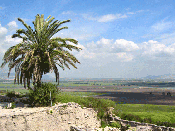 |
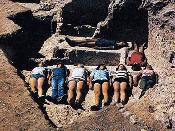 |
| |
|
|
|
 |
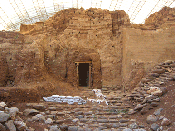 |
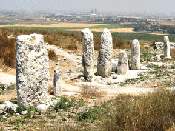 |
| |
|
|
|
Read about the discovery of the Dead Sea
Scrolls in
Shepherds, Scholars and
the Dead Sea Scrolls |
|
|
|
Gila Yudkin,
who calls herself a Connecticut-born
Yankee living now in King David's Court, has
been guiding since 1978. This summer,
in addition to playing the role of “Big
Mama” facilitator for 138 team members from
17 countries and 5 continents at the Ramat
Rahel dig, Gila Yudkin enthusiastically
shared her archeological insights and
anecdotes on tours of Megiddo, Masada,
Caesarea, Capernaum, Qumran and the Kidron
Valley. If you would like Gila to guide your
next pilgrimage, book early and directly
with Gila! |
| |
|
Copyright 2008 Gila Yudkin. Permission
needed for any reuse. |
|
|
|
GILA
YUDKIN
•
TCHERNIKOVSKI
64A
•
JERUSALEM
•
ISRAEL
gila@itsgila.com
HOME
•
BOOK
GILA
• TIPS
FOR TOURS •
ABOUT GILA
|
|

